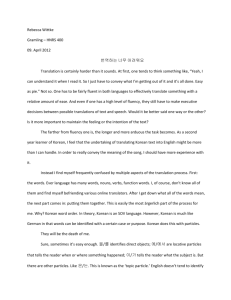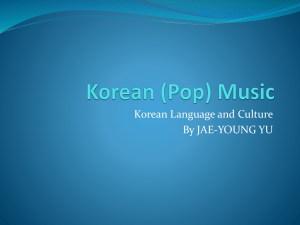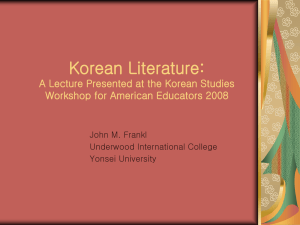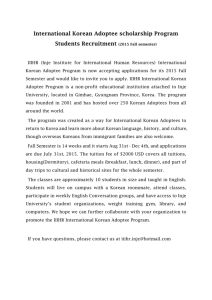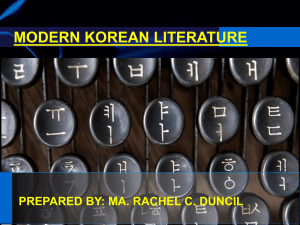5C Nakamura Session Title: Different Medical Systems Session
advertisement
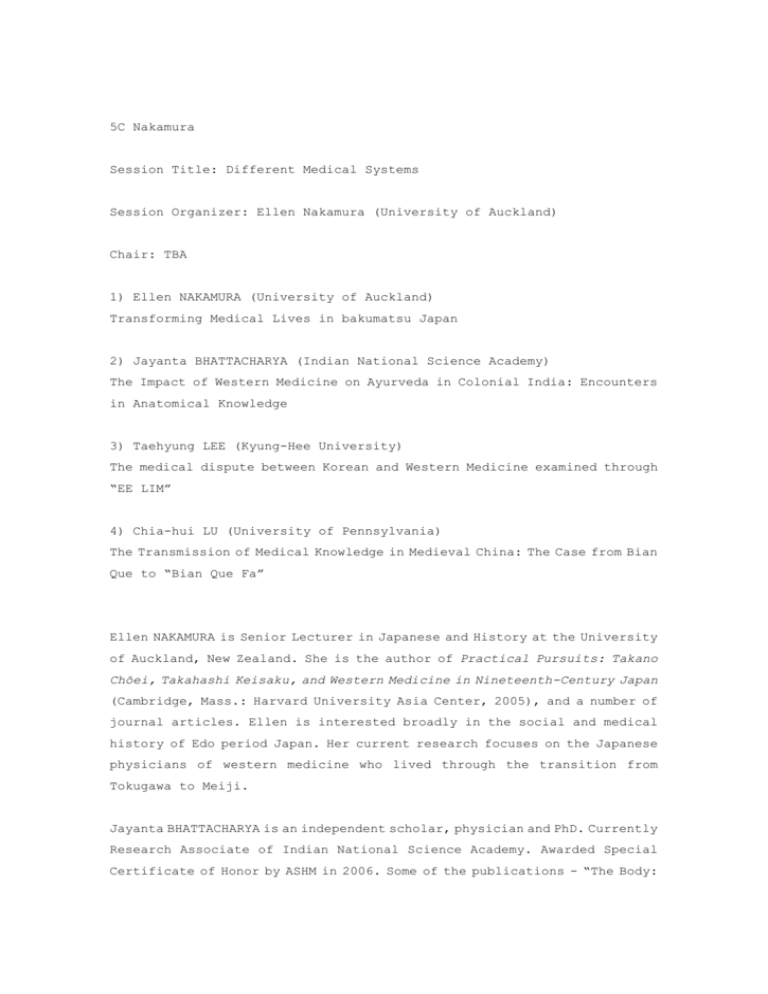
5C Nakamura Session Title: Different Medical Systems Session Organizer: Ellen Nakamura (University of Auckland) Chair: TBA 1) Ellen NAKAMURA (University of Auckland) Transforming Medical Lives in bakumatsu Japan 2) Jayanta BHATTACHARYA (Indian National Science Academy) The Impact of Western Medicine on Ayurveda in Colonial India: Encounters in Anatomical Knowledge 3) Taehyung LEE (Kyung-Hee University) The medical dispute between Korean and Western Medicine examined through “EE LIM” 4) Chia-hui LU (University of Pennsylvania) The Transmission of Medical Knowledge in Medieval China: The Case from Bian Que to “Bian Que Fa” Ellen NAKAMURA is Senior Lecturer in Japanese and History at the University of Auckland, New Zealand. She is the author of Practical Pursuits: Takano Chōei, Takahashi Keisaku, and Western Medicine in Nineteenth-Century Japan (Cambridge, Mass.: Harvard University Asia Center, 2005), and a number of journal articles. Ellen is interested broadly in the social and medical history of Edo period Japan. Her current research focuses on the Japanese physicians of western medicine who lived through the transition from Tokugawa to Meiji. Jayanta BHATTACHARYA is an independent scholar, physician and PhD. Currently Research Associate of Indian National Science Academy. Awarded Special Certificate of Honor by ASHM in 2006. Some of the publications - “The Body: Epistemological Encounters in Colonial India” in Making Sense of Health, Illness, and Disease, (Rodopi, 2004); “Encounter in Anatomical Knowledge: East and West,” IJHS, 43.2 (2008) 163-210; “The knowledge of anatomy and health in Āyurveda and modern medicine: colonial confrontation and its outcome,” Eä - Revista de humanidades médicas, 1:1 (2009): 1-51. Edited Bharatiya Patabhumite Chikitsa Bijnaner Itihas: Ekti Samkshipta Pryalochana (History of Medicine in Indian Perspective: A Brief Review), Kolkata, 2010. Contributor to Health and Medicine in Colonial India: Diffusion and Contestation, ed. Deepak Kumar, OUP, Delhi, (forthcoming 2012). Taehyung Stephan LEE is Ph.D. Candidate at the Dept. of Medical History, College of Korean Medicine, KyungHee University. His research field is medical dispute between Korean and Western medical doctors in the modern era. He focuses how Korean Medical doctors have strived to keep the tradition of Korean Medicine, and adapted in the modern society. He is also researching the meaning of CAM (complementary and alternative medicine) and Integrative Medicine in the present. Chia-hui LU pursued her master's degree in performance studies at New York University, now she is a Ph.D student in both Folklore Program and East Asian Languages and Civilizations Program of University of Pennsylvania. Her academic interests include folklore and bodylore, magical healing and medicine in medieval China, mythology and religion in pre-modern society. ABSTARCT: The Impact of Western Medicine on Ayurveda in Colonial India: Encounters in Anatomical Knowledge Jayanta Bhattacharya Research Associate Indian National Science Academy Email: drjayanta@gmail.com I shall argue that Western medicine has passed through epistemological and paradigmatic shifts from Bedside medicine to Hospital medicine to Laboratory medicine (and, now, Techno-medicine). The modern anatomical knowledge, instead of previous two-dimensional perception of the body, disease began to be perceived to being located within a three-dimensional body in modern medicine. The singular act of post-mortem dissection differentiated Hospital medicine from Bedside medicine and established its unquestionable authority over Indian medical knowledge systems. Throughout the entire period following European renaissance and industrial revolution there emerged capital, competitive market economy, working class and predominance of technology in social life which lead to an objective mode of learning in social life and psyche. It was altogether different from the Indian mode of learning. These specific phenomena prepared the canvas over which the new knowledge of knowing the body and health could be written for the first time and for ever in human history. The history of Calcutta Medical College (CMC) is intertwined with the rise of Hospital medicine in India. Hospital medicine is a unique phase in the evolution of medicine. A utilitarian approach and military need to provide trained medical personnel in different detachments and hospitals prompted the earliest official involvement with medical education in India. The singular act dissection-based anatomical knowledge brought in some indelible changes in the perception of body, disease, and self of Indian population. Medicine ushered in a new paradigm of knowing the body. CMC had embraced within its matrix an ensemble of different medical practices at the same time – medical teaching at UCL, long-drawn surgical practices of the Company’s surgeons and the discriminatory colonial practices. Emphasis was placed on producing ‘capable practitioners’, rather than ‘capable enquirers and practitioners’. Ayurveda had to face the most formidable encounter in its history of more than a millennium. In an act of mimicry, Ayurvedics had to abandon the basic mode of traditional learning of Ayurveda. They had to negotiate their position between being ‘modern’ and ‘original’ at the same time. Modern medical terms reconstituted Ayurvedic terminologies. Epistemological struggle between hospital medicine and empirical knowledge still goes on in India. The medical dispute between Korean and Western Medicine examined through 『EE LIM』 1Taehyung Lee 1Department of Medical History, College of Korean Medicine, Kyung-Hee University Objective: On September 6, 1951, the National Assembly passed the Medical Services Law which included Korean Medical doctors in a dual system. Although the government acknowledged Korean Medical Doctors as official health care providers, criticism regarding its modernity persisted. This paper focuses on the medical dispute between Korean and Western Medicine after the year 1951 risen from the problem of modernization of Korean Medicine. Methods: This paper looked into the medical dispute between Korean and Western Medicine in through 『EE LIM』. 『EE LIM』 is a scholarly journal published by Korean Medical doctor Bae Won-Sik. Articles regarding the medical dispute between Korean and Western Medicine were selected, categorized and analyzed. Results: The main questions against Korean Medicine were: whether it was scientific or not, and whether there was a possibility of systematization. Several opinions were brought up on these issues. 1) Some people criticized Korean Medicine as being unscientific based on modern science. 2) Others emphasized the identity of Korean Medicine against the critics. 3) Another group of people wanted to study Korean Medicine using modern methods and obtain merits from both sides. Conclusion: The different understanding of the term ‘science’ led to diverse discussions on the direction of Korean Medicine's progression. The narrow meaning of science only considers Korean Medicine as an object of modern scientific and medical study. But if the meaning is broadened, containing empirical aspects, Korean Medicine can be included as a category of science based on its clinical utility. If we wish to increase the clinical utility of Korean Medicine in the future, a more open-minded study on its value needs to be performed. Key words: EE LIM, Medical dispute between Korean and Western Medicine, scientification, systematization, modernization, Paper Proposal for the Sixth Conference for the Asian Society for the History of Medicine, Yokohama 14-15 December 2012 Ellen Nakamura, University of Auckland, New Zealand ‘Transforming Medical Lives in bakumatsu Japan’ Abstract What happened to doctors of Tokugawa era ranpō medicine who were knowledgeable about aspects of western medicine but lacked a modern medical education? How did they experience the transition from Tokugawa to Meiji medicine? This paper is part of a project that seeks to understand how ordinary doctors of Dutch-style medicine lived out the transition to modern western medicine in the bakumatsu and early Meiji periods, both as individuals and as interconnected communities of practitioners. Influential ranpō physicians such as Matsumoto Jun (1832-1907) and Nagayo Sensai (1838-1904) are well known for their contributions to medical policy and the way in which they helped to shape the future of Japanese medicine. Histories of this era have tended to focus on their successes and on the gradual nationalization and institutionalization of western medicine. The recognition and promotion of western medicine as orthodox by the Meiji government was in one sense a victory for the ranpō physicians who had long touted its benefits. The ranpō physicians ensured the dominance of western medicine and initially enjoyed a period of considerable prestige. On the other hand, the commitment to modern western medicine also ensured the eventual demotion of the ranpō physicians themselves. By focusing on the activities of ordinary practitioners we can gain a more complete understanding of Japan’s medical transformation. Indeed, it was not only the legislators who changed Japanese medical culture, but those local physicians who were forced to re-construct their identities and sometimes their daily work itself. In this study I am concerned with the careers of transitional physicians who did not re-train and who used their background in ranpō medicine as the foundation for their claim to professional expertise. I will use as examples the biographies of Mise Shūzō (1839-1877) and Ishii Kendō (1840-1882) to explore how they responded to the challenges of the Meiji era.

